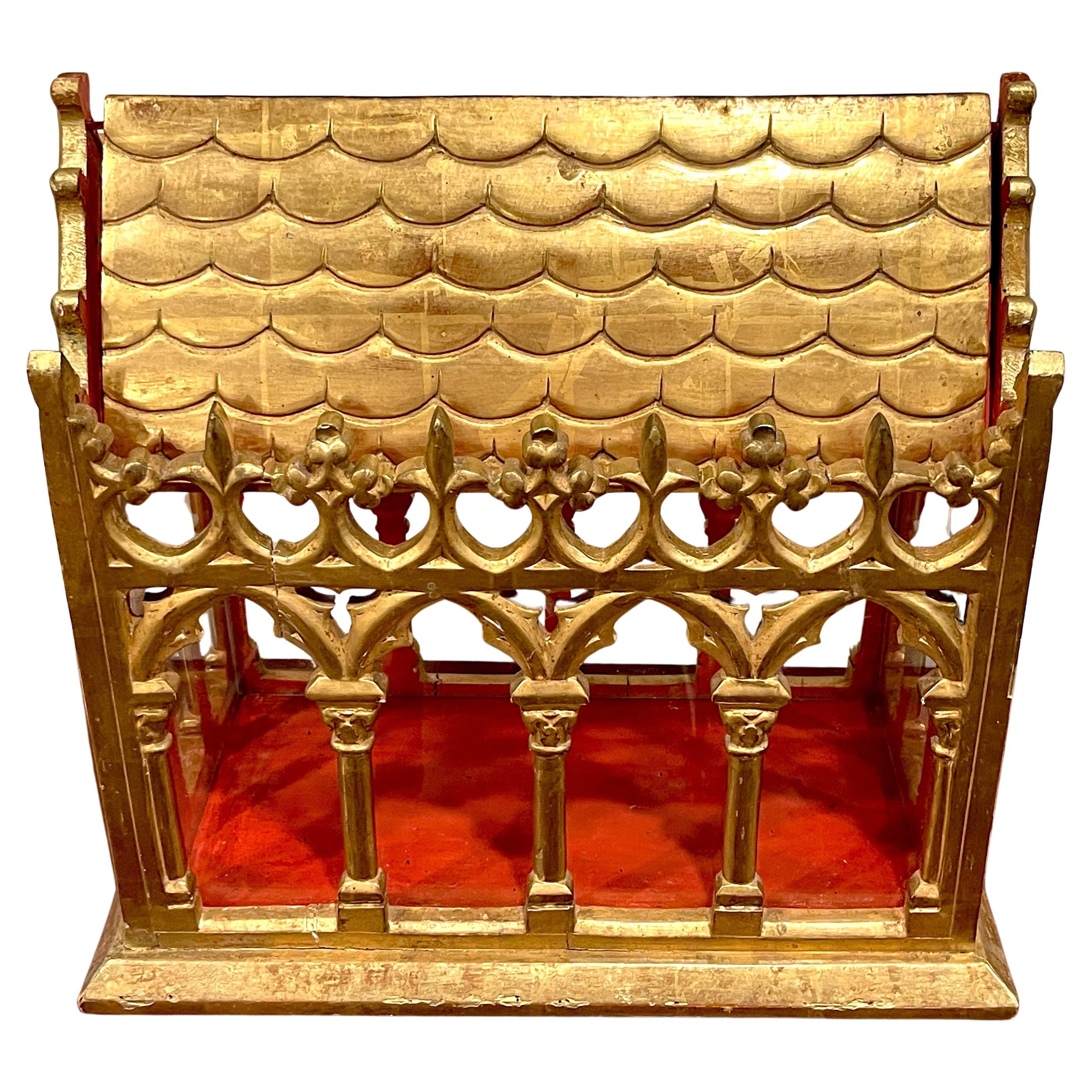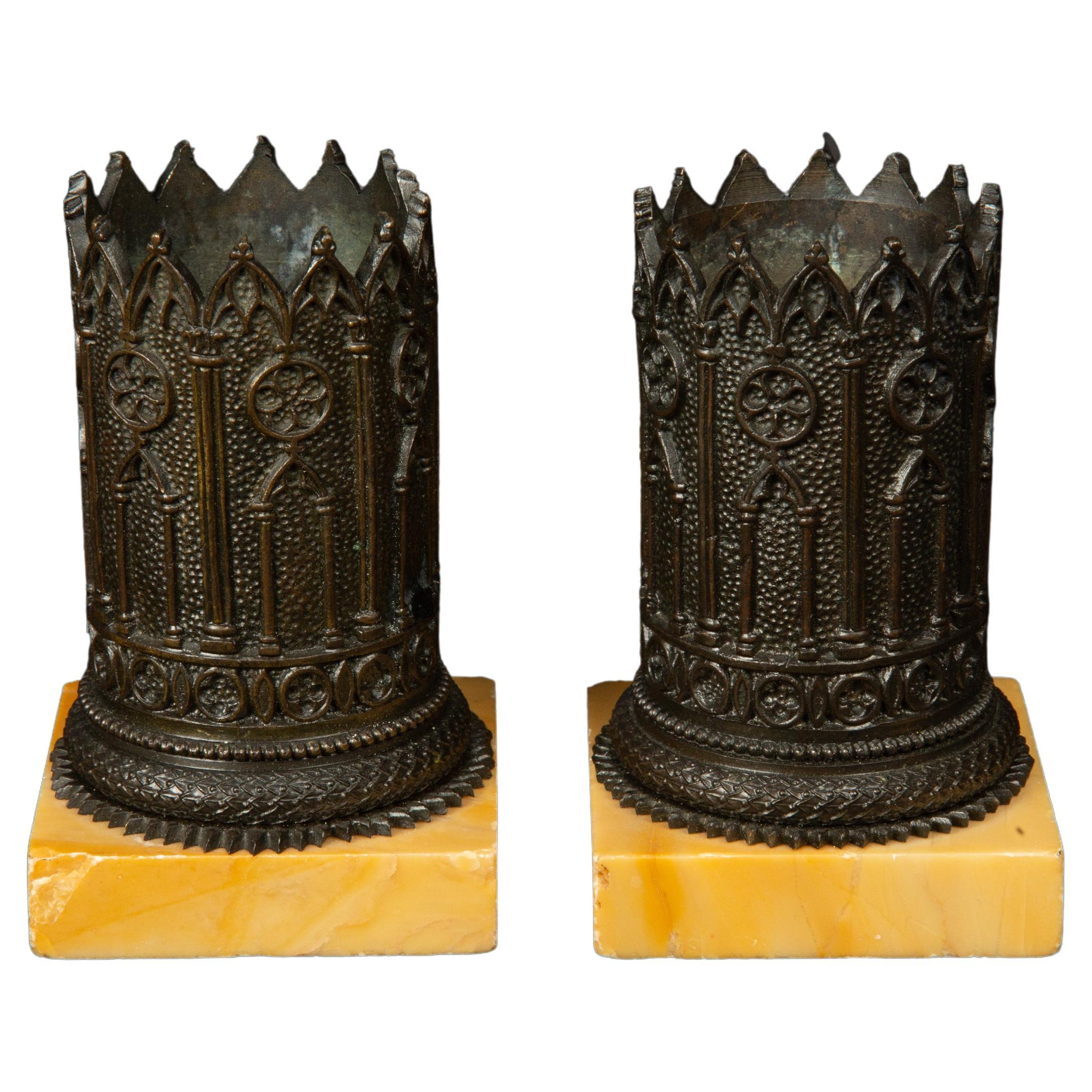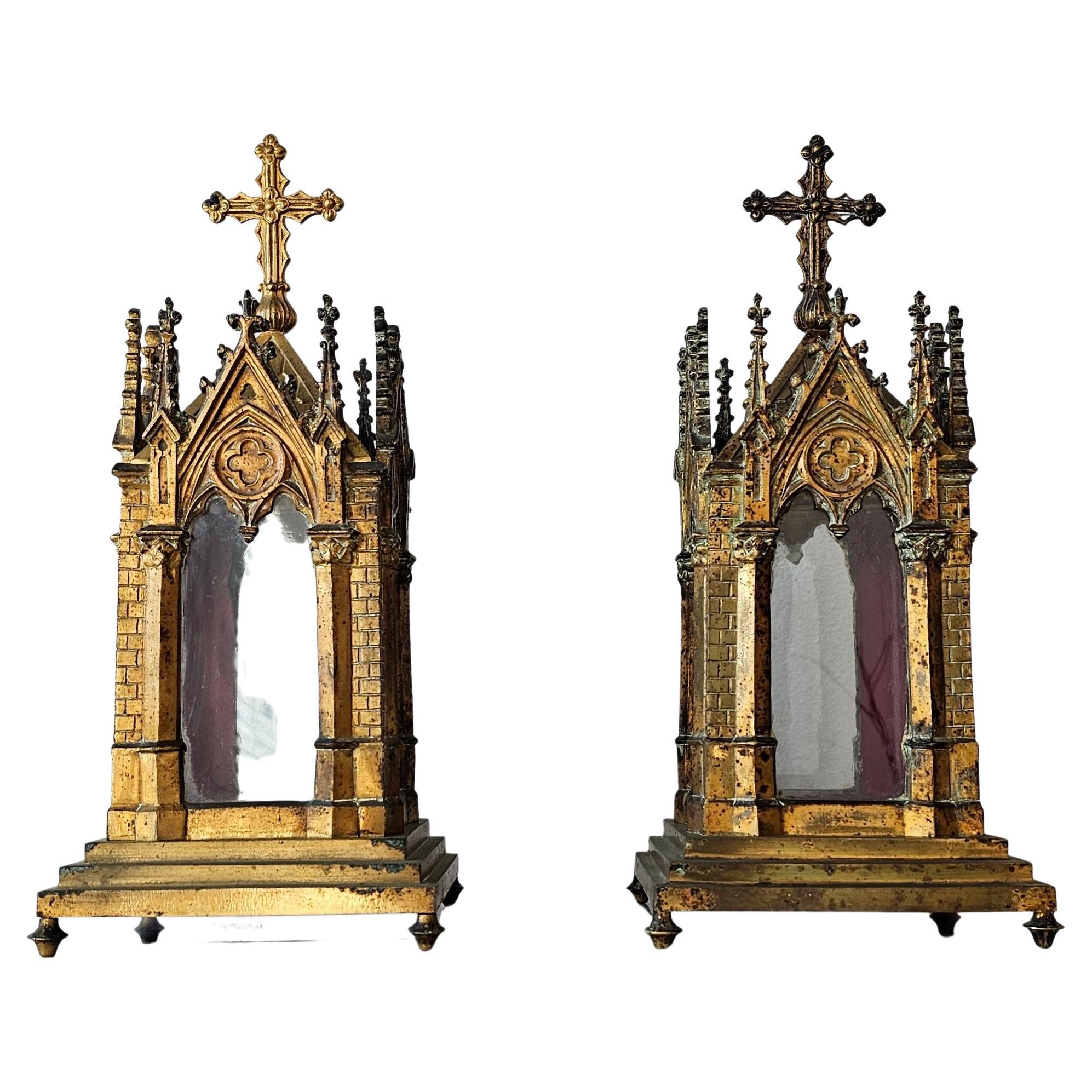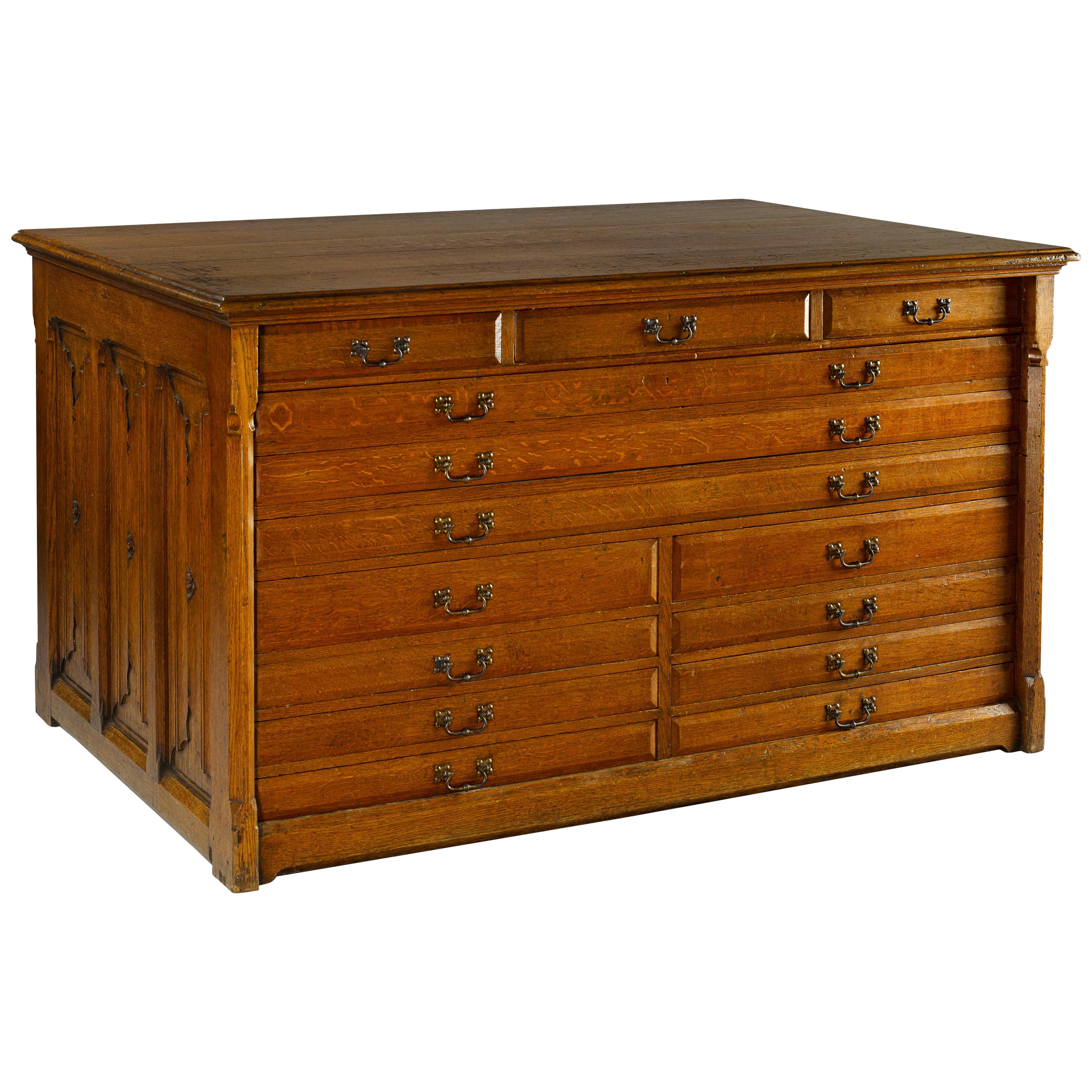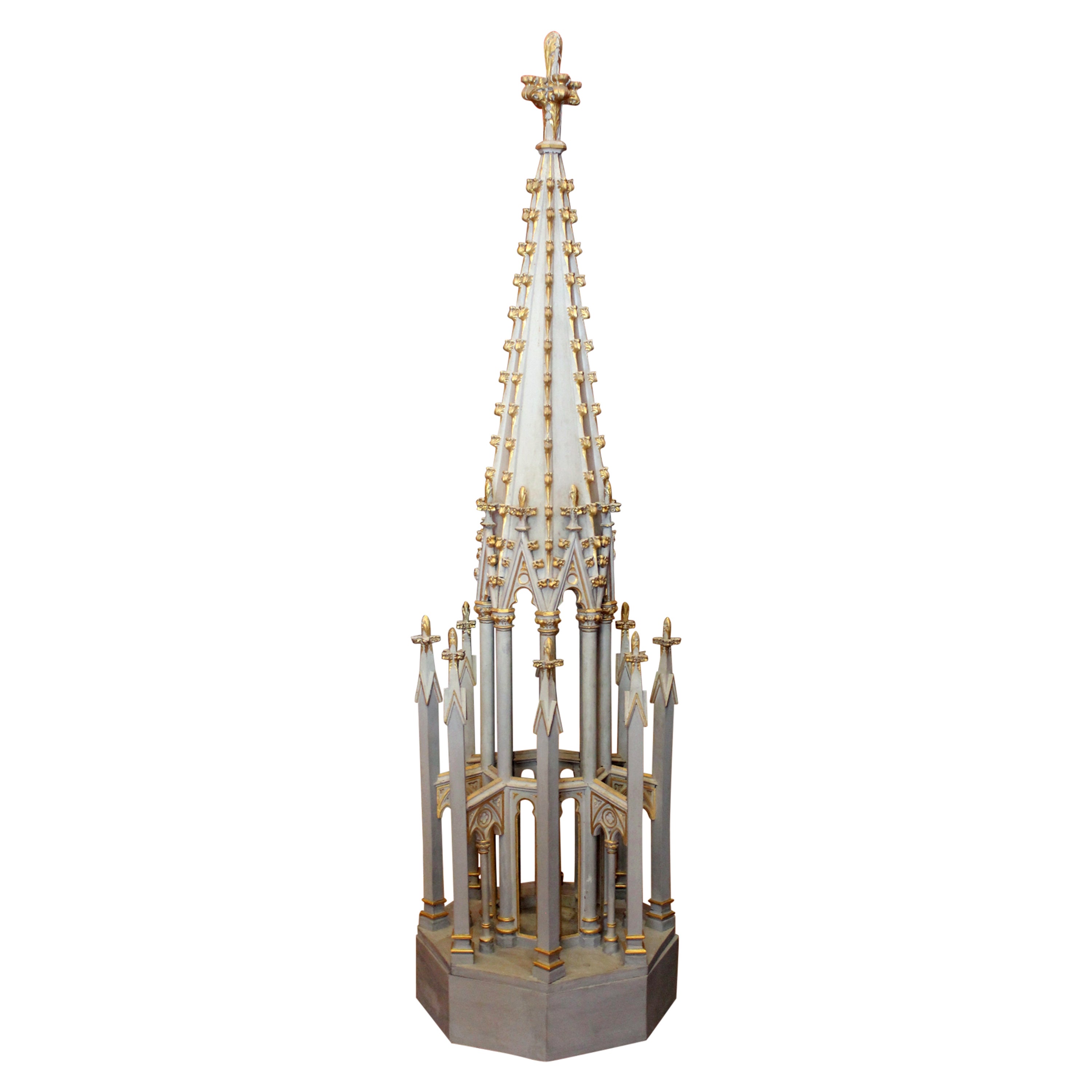Items Similar to Late 19th Century Gothic Revival Reliquary Casket
Want more images or videos?
Request additional images or videos from the seller
1 of 21
Late 19th Century Gothic Revival Reliquary Casket
About the Item
A Gothic Revival reliquary. Circa late 19th / early 20th century. Made of solid oak with fine carving.
Reliquaries have been used to store relics since the Middle Ages. In sacred architecture they are often located behind the main altar in the chancel. In addition to classical, often church-like caskets, anthropomorphic, so-called "speaking" reliquaries were also made, which already inform the viewer about their contents through their own design. Mostly they were made of precious metals and decorated with rich sculptural ornaments or precious stones. One of the most famous examples of reliquaries is the Epiphany shrine of Nicholas of Verdun from the late 12th or early 13th century in Cologne Cathedral.
The reliquary offered here has an architectural structure with a rectangular ground plan. The three-sided glazed box with a dormer roof rests on a plinth.
A total of 8 columns of Corinthian order form the arcades which are crowned on both long sides by 3 lancets each and enclose the lancet windows on the 3 visible sides. A small lockable door is located in the centre of the back.
The roof is coloured and carved with diamond-shaped tiles with crosses. The roof prince is crowned by cross-leaf decoration set in gold.
Both the plinth zone all around and the tympana of the lashings are decorated with coloured semicircular glass stones. One stone on the back at the base is missing.
Other usual iconographic elements in the form of representations of saints etc. have been omitted, thus placing the focus on the architectural structure in the Gothic style.
Remains on the back show that the reliquary was originally at least partially gilded with gold leaf.
The interior still has an old turquoise/blue setting.
Partly newly glazed.
Dimensions:
76 cm high / 29.9 inch high,
77 cm wide / 30.3 inch wide,
46 cm deep / 18.1 inch deep.
Information about the origin and the original contents are unfortunately not known.
- Dimensions:Height: 29.93 in (76 cm)Width: 30.32 in (77 cm)Depth: 18.12 in (46 cm)
- Style:Gothic Revival (Of the Period)
- Materials and Techniques:
- Place of Origin:
- Period:
- Date of Manufacture:Unknown
- Condition:Repaired. Replacements made: Glass panes has been replaced. Wear consistent with age and use.
- Seller Location:Dusseldorf, DE
- Reference Number:1stDibs: LU3999130652852
About the Seller
5.0
Vetted Seller
These experienced sellers undergo a comprehensive evaluation by our team of in-house experts.
Established in 1975
1stDibs seller since 2018
61 sales on 1stDibs
Typical response time: <1 hour
- ShippingRetrieving quote...Ships From: Dusseldorf, Germany
- Return PolicyA return for this item may be initiated within 14 days of delivery.
More From This SellerView All
- Pair of Late 19th Century Gothic Revival Oak and Cast Iron BalustradesLocated in Dusseldorf, DENeo-Gothic choir screens resp. 2 balustrades from the late 19th century. Solidly made of oak wood and cast iron. Choir screens have been part of the interior decoration of churche...Category
Antique Late 19th Century European Gothic Revival Balustrades and Fixtures
MaterialsIron
- Late 19th Century Austrian Sewing TableLocated in Dusseldorf, DEViennese baroque sewing table, around 1860. Solid walnut and veneered, as well as other various precious woods. Transverse oval top with musical marquetry motif consisting of a...Category
Antique Late 19th Century Austrian Baroque Revival Side Tables
MaterialsBirdseye Maple, Maple, Walnut
- Late 19th Century CandlestickLocated in Dusseldorf, DELarge candlestick from the late 19th century. Made of wood and carved, as well as polychrome painted. Ornamentally and florally carved column on a ...Category
Antique Late 19th Century European Candlesticks
MaterialsHardwood
- Large Early 20th Century Louis XVI Style BookcaseLocated in Dusseldorf, DEBookcase or library in the Louis XVI style from around 1900. Solidly made of oak wood, with floral and ornamental carving. Extraordinarily high corpus, coffered at the sides, with c...Category
Early 20th Century French Louis XVI Bookcases
MaterialsGlass, Oak
- 19th Century French Renaissance Revival Bookcase Cabinet Made of PineLocated in Dusseldorf, DEA 19th Century French bookcase in Renaissance style, made of solid pine. Consists of an upper and a lower part with a total of 4 doors. Facade-like front. Pilaster strips with flut...Category
Antique 19th Century French Renaissance Revival Bookcases
MaterialsFir, Pine
- 19th Century Italian Renaissance Revival Writing Desk Made of WalnutLocated in Dusseldorf, DEA 19th century Italian writing desk in renaissance revival style made of solid walnut. The table can be used as a writing desk or as a dining table. Both sides look the same. ...Category
Antique 19th Century Italian Renaissance Revival Desks and Writing Tables
MaterialsWalnut
You May Also Like
- 19th Century French Gothic Cathedral Giltwood & Glass Reliquary / VitrineLocated in West Palm Beach, FL19th Century French gothic cathedral giltwood & glass reliquary / vitrine France, mid-19th century. A reliquary is a container for the display an...Category
Mid-20th Century French Gothic Revival Religious Items
MaterialsGlass, Giltwood
- Late 19th Century Grand Tour Gothic Revival Bronze and Marble Desk AccessoriesLocated in New York, NYLate 19th Century Grand Tour Gothic Revival Bronze and Marble Desk AccessoriesCategory
Antique Late 19th Century European Gothic Revival Architectural Models
MaterialsMarble, Bronze
- Fine 19th Century French Neo-Gothic Gilt Metal Cathedral Church Reliquary PairLocated in Forney, TXA stunning pair of very fine quality French Neo-Gothic gilt metal church reliquaries. circa 1860s Most impressive objets d’art, born in France in the second half of the 19th century, most likely Parisian gilded bronze and brass ormolu work, exceptionally executed sculptural form, the exquisitely detailed architectural cathedral shaped case having a removable pointed steeple roof with cross finial, opening to relic display case surrounded on all sides by original glazed glass panes, stepped base, rising on disc feet. Signed, stamped by maker / bronzier "BC" (unknown) model "5096" and other faint marks to lid interiors. Additional photos available upon request Dimensions: (approx) 14.75" High, 6.75" Wide, 6.75" Deep; 13.25 lbs total History: A reliquary (also referred to as a shrine, by the French term châsse or monstrance) is a container for important religious relics. The earliest reliquaries were essentially boxes, either simply box-shaped or based on an architectural design, taking the form of a model of a church with a pitched roof. These latter are known by the French term chasse, and typical examples from the 12th to 14th century have wooden frameworks with gilt-copper plaques nailed on, decorated in champlevé enamel. Limoges was the largest production centre; NB the English usage differs from that of the French châsse, which denotes large size rather than shape. Relics of the True Cross became very popular from the 9th century onward and were housed in magnificent gold and silver cross-shaped reliquaries decorated with enamels and precious stones. From about the end of the 10th century, reliquaries in the shape of the relics they housed also became popular; hence, for instance, the skull of Pope Alexander I was housed in a head-shaped reliquary. Similarly, the bones of saints were often housed in reliquaries that recalled the shape of the original body part, such as an arm or a foot. A philatory is a transparent reliquary designed to contain and exhibit the bones and relics of saints. This style of reliquary has a viewing portal to view the relic inside. The feretrum was a medieval form of reliquary or shrine containing the sacred effigies and relics of a saint. During the later Middle Ages, the monstrance form, primarily used for consecrated hosts, was sometimes used for reliquaries. These housed the relic in a rock crystal, or glass capsule mounted on a column above a base, enabling the relic to be displayed to the faithful. Reliquaries in the form of large pieces of metalwork jewellery also appeared around this time, housing tiny relics such as pieces of the Holy Thorn, notably the Holy Thorn Reliquary now in the British Museum. Condition: Superb museum quality examples, in excellent original unrestored antique condition with beautifully aged patina. Wear consistent with age and use. Heavily patinated - scattered oxidation. Overall wonderful examples. Typically reliquaries were not sold in pairs, so to find a matching pair such as this is exceptionally rare. Worldwide shipping available Local pickup available near Dallas, Texas Additional: We here at Lynx Hollow Antiques love religious antiques, from Christian tabernacles, Catholic altarpiece, life-size Buddhist temple sculptures, Hindu votive offerings, 16th century Islamic mosque architectural salvaged windows...Category
Antique Mid-19th Century French Gothic Revival Religious Items
MaterialsBrass, Bronze
- Rare Victorian Mid-19th Century Gothic Revival Library Architects Plan ChestLocated in Worpswede / Bremen, DEA neo-gothic mid-19th century library plan chest having an arrangement of eleven short and three long drawers to one side, the other side with three short drawers above gothic style linen fold panelling, centred with the carved monogram ‘HP’, further matching panelling to the sides. A stunning plan chest of good propartions and with a nice patina. Provenance: Sherborne School, an independent school in north-west Dorset, England, established in 1550. Among the ‘Old Shirburnians’ are for example the writer John Cowper Powys, the actors Jeremy Irons und Charlie Cox, Chris Martin, leadsinger of the band Coldplay as well as Sheikh Tamim bin Hamad Al Thani...Category
Antique Mid-19th Century English Gothic Revival Commodes and Chests of D...
MaterialsOak
- French 19th Century Gothic Revival Hand Carved, Lacquered, Parcel Giltwood SpireLocated in Firenze, ITAn impressively large and well detailed French late 19th century architectural model of a Gothic inspired transept-spire or church pinnacle. This Neo Gothic decorative finial is han...Category
Antique 19th Century French Gothic Revival Architectural Elements
MaterialsWood, Giltwood
- Early 19th Century Parcel Gilt Gothic Revival Harp By Sebastian ErardBy Sébastien ÉrardLocated in Dublin, IEA very fine and elegant Regency Satinwood and parcel-gilt double action Harp from the workshop of the famous harp and piano maker Sebastian Erard (1752-1831), decorated in the Grecia...Category
Antique Early 19th Century English Gothic Revival Musical Instruments
MaterialsBrass
Recently Viewed
View AllMore Ways To Browse
Blue Items
Small Antique Items
Gilded Items
Gothic Revival Carved
Gothic Fine
Gothic Antique Doors Gothic Doors
Antique Gothic Door
Antique Gothic Doors
Gothic Revival 20th Century
Classical Revival Style Furniture
Gothic Revival Oak Carved
Religious Gold Cross
Used Reliquaries
19th Century Casket
Gothic Style Door
Century Reliquary
Used Roof Windows
Gothic Revival Church
